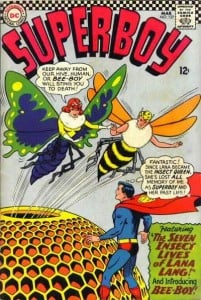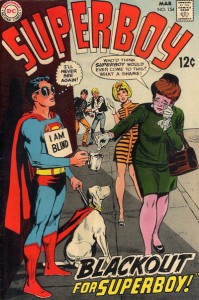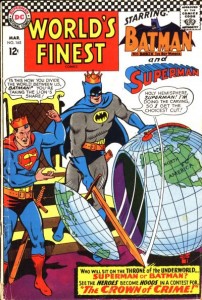So I like to paw through the back issue bins at conventions, judging books by their cover, buying cheap ($1-3) copies of old comics! Usually it’s something from the Silver or Bronze Age, usually published by DC Comics. (Marvel’s covers never seem to grab me…they might be well-designed, but there’s no “hook”. Of course, it was Amazing Spider-Man #254 which got me hooked as a collector…)
I found quite a few interesting and fun comics at New York Comic Con. The stories, for the most part, were fun, although a few had continued stories. Sometimes the ads would be interesting, like a fly caught in amber, of companies long extinct, of toys long since forgotten. But the best find? Statements of Ownership!
What? You don’t know what those are? Well, we’ll let Beat Best Friend John Jackson Miller explain!
Q: When did circulation figures first appear in comics?
A: The Statement of Ownership, found in the most recent U.S. Code as Section 3685, Title 39 (it was once under Section 4369, Title 39), has been required of publishers who ship Second Class since the 19th Century. But it was in 1960 that it became the Statement of Ownership and Circulation, as that was the year that publishers were first required to list their average paid circulation for the year.
Second Class mail was used to ship magazines at a cheaper rate. Once publishers qualified for this, once a year they had to publish some basic information, usually who owned the publisher, and circulation figures! Not estimates, like the current numbers from Diamond, but the real deal!
So, what were numbers like back then? Here’s a few snapshots! BBF JJM has a bigger database. Go spend a few hours at The Comic Chronicles (and try not to dispair)!
April-May 1974 (Date of filing, October 1, 1973)
Section 11A. Total number copies print (Net Press Run)
Average number copies of each issue during preceding 12 months: 313,000
Actual number of copies of single issue published to filing date: 319,000
11B. Paid circulation
1. Sales through dealers and carriers, street vendors and counter sales:
Average number copies of each issue during preceding 12 months: 145,054
Actual number of copies of single issue published to filing date: 121,585
[46% for the year, 38% for the latest month Basic rule of newsstand sales: you print three copies to sell one.]
2. Mail subscriptions:
Average number copies of each issue during preceding 12 months: 717
Actual number of copies of single issue published to filing date: 1,009
[one-third of one percent of all copies printed were for subscriptions]
11C. Total paid circulation:
Average number copies of each issue during preceding 12 months: 145,771
Actual number of copies of single issue published to filing date: 122,594
11D. Free distribution by mail carrier or other means:
1. Samples, complimentary, and other free copies:
Average number copies of each issue during preceding 12 months: 100
Actual number of copies of single issue published to filing date: 100
2. Copies distributed to news agents, but not sold:
Average number copies of each issue during preceding 12 months: 164, 709
Actual number of copies of single issue published to filing date: 195,255
[What happened to these unsold copies? The covers were ripped off and sent back for credit. The rest of the comic was supposed to be destroyed (sent to a landfill or recycled) but sometimes, these coverless comics were sold on the grey market.]
11E. Total distirbution (Sum of C and D):
Average number copies of each issue during preceding 12 months: 310,580
Actual number of copies of single issue published to filing date: 317,949
11F. Office use, left-over, unaccounted, spoiled after printing:
Average number copies of each issue during preceding 12 months: 2.420
Actual number of copies of single issue published to filing date: 1,051
11G. Total (Sum of E & F–should equal net press run shown in A):
Average number copies of each issue during preceding 12 months: 313,000
Actual number of copies of single issue published to filing date: 319,000
Sales figures for Wonder Woman in the 1960s:
1961 230,000 (29)
1962 215,000 (27)
1963 NO DATA
1964 NO DATA
1965 209,918 (64)
1966 220,168 (62)
1967 175,000 (76)
1968 166,365 (50)
1969 171,197 (44)
1973 145,054
— —
Got all that? From now on, I’ll list everything by the section numbers, with the figures being annual and latest month.
March 1969 (Date of Filing: October 1, 1968)
A. 892,000 992,000
B.1 531,000 590,000
B.2 1,135 819
C. 532,135 590,819
D. 386 386
..[No D.2, see F below.]
E. 532,521 591,205
F. 359,479 400,795
G. 892,000 992.000
Paid total circulation (C) equals 60%!
According to JJM, this series was #4, behind Superman, Archie, and Batman. Charlton’s Fightin’ Army was the lowest selling title for that year, with paid circulation of 111,820.
—
March 1967 (Date of Filing: October 1, 1966)
A. 766,000 856,000
B.1. 508,000 580,000
B.2. 5,201 5,766
C. 513,201 585,766
D. 330 330
..[No D.2, see F below.]
E. 513,531 586,096
F. 252,469 269,904
G. 766,000 856,000
67% sell-through! Quite good!
#6 for the year.
—

March 1966
Hmmm… a statement, but no numbers. Let’s see if JJM has the numbers…
672,681 (#2 for 1965!)
— — — — —
This, of course, is quite different from today (although few publishers currently report Statements of Ownership). Most sales are via the non-returnable Direct Market (and represent sales to retailers, not to actual readers like in the 1960s), but the sales data does not differentiate between newsstands, comics shops, or other retailers. Subscription fulfillment rates are higher. Was it unusual for children to subscribe to magazines in the 1960s? (It was sort of a big deal for me as a child in the 1970s.)
For Amazing Spider-Man in 2008, only 17,515 of 125,019 copies (average) were returned. If that number represents a 2/3 return rate, then roughly 26,000 copies were distributed through newsstands.
Will digital comics return comics to the numbers of the 1960s? How will we know? Does the Audit Bureau of Circulations track comics publishers, either in print or via consolidated media reports? (And do digital comics contain advertisements?) Or do we rely on graphic novel sales to track influence from single issues, since digital copies, either paid or pirated, encourage sales of paper editions? Or will we have to rely on creators royalty statements? How do you audit those sales, if there are no independent agencies tabulating sales?
Periodical comics existed for twenty years before the federal government required publishers to file Statements of Ownership, so much of the data before then is general or apocryphal. Even now, many publishers do not ship comics via Second Class (such as DC), so even that data source is unreliable or sparse.
Like an advertisement for some long forgotten toy or novelty, these Statements provide a nice look back at a bygone era. Like a gorilla or motorcycle on the cover, they provide a bit of fun for collectors.










RT @Comixace: Fool’s Gold: Searching for Longbox Treasure: Sales Figures!: Sales figures from the 60s and 70s! http://t.co/QKdekQkX
Wow, that’s a lot of comics. I wonder why there so low now. I doubt we will ever see numbers like that again.
Part of it is distribution… there were a lot of outlets for magazines and comics, well into the 1980s, partly due to the efforts of the Comics Magazine Association of America (yes, the Comics Code people). Spinner racks were commonplace. I remember when Robin #1 sold out, so I waited three weeks and bought a newsstand copy from the gas station on the way to the comics shop. Before I made the weekly pilgrimage to the comics shop, I made the pilgrimage to the local shopping center, where B.Dalton, Waldenbooks, and a local newsstand sold comics.
Partly, if you look at the number SOLD, you had to print two to three copies to sell one. It was less likely that newsstands would adjust their orders automatically, as is done now, to reduce waste. Or newsstands got one copy automatically as part of a weekly shipment, whether it’s Superman or Young Teen Love.
DC Sales Figures? Needs more snark.
Oooh, fightin’ words on Silver/Bronze Age Marvel covers! I’m surprised no one has jumped on you yet.
(Personally, I agree, except for Kirby and Steranko covers. And Marvel Team-Up. And Marvel Fanfare. OK, maybe I don’t exactly agree!)
I think the “newsstand revival” reading of digital comics isn’t exactly right, mainly because comics today, even periodical comics, are mostly designed for bookstore shopping and reading habits. Unlike, say, Esquire or Vanity Fair, comics periodicals (aside from Archie titles) aren’t designed for random dipping in to an issue now and then — they’re for people who follow certain characters or story universes or writers, just like avid book shoppers do.
The promise of digital comics today is more of an expanded bookstore/comics store than a return to the newsstand. (Unless the comics themselves change, of course.)
Note that the rankings I have for the 1960s are soon to completely change, as I have in some cases more than doubled the number of found Statements I have for each year. I’m planning a mammoth update, which will include the 1970s and onward. The most important addition is that I have almost completed Dell, which, as expected, blows away everything else; I’ve also found them in places I never thought to look before. (CarToons, anyone?)
Marvel, Archie, and Mad still run the statements; the 2012 ones are about to appear. I’m gathering these now as well; kindly folks who’d like to help can send scans to the contact address on my Comichron website. (I will be running posts listing what I am missing from previous years; I have isolated specific titles and years where Statements are known or expected to appear, which should make it easier. I have most of them at this point, but completion is the goal.)
A small correction: Statements of Ownership have been required in all magazines sold through Second Class (or now Periodical Class) mail, including comics, since the 1800s. Comics did have the statements before 1960 — I have found hundreds. But they did not require numbers until 1960 (and after that, many publishers stumbled in confusion over what they were required to publish). Those statements are still collected by historians as they help us track, well, Ownership of the publishing houses across time.
(And just as I hit send, the postman delivered a pile of comics from the 1960s and 1970s with some remaining statements. Folks can also help in the scavenger hunt at the Comichron Facebook page, http://www.facebook.com/comichron.)
Even as a teenager I loved seeing these numbers turn up once a year in my comics.
HA!
Tut mir wirklich leid. Ich bin Deutscher-Amerikaner, so kann ich nur passiv-aggressivisch Kommentar aufbringen.
Marvel covers post-1961, just don’t have those crazy gimmicks, they never really embraced the Donenfeld Theorem of Cover Gimmicks, as defined by Mark Waid in Secret Origins #40 (May 1989). You look at a Marvel cover, and it doesn’t DEMAND you read that issue, to find out why there’s such a crazy cover!
However, Marvel does have a better sense of the absurd. Howard the Duck, Byrne’s She-Hulk, Deadpool, the Impossible Man…
But if you have an example of a Marvel cover which grabs you by the eyeballs and makes you tear open the cover, let me know!
Ronald Montuori liked this on Facebook.
Hannah Menzies liked this on Facebook.
Barry Hollifield liked this on Facebook.
Kelly Heinze liked this on Facebook.
Alvin Kalelski liked this on Facebook.
Comments are closed.